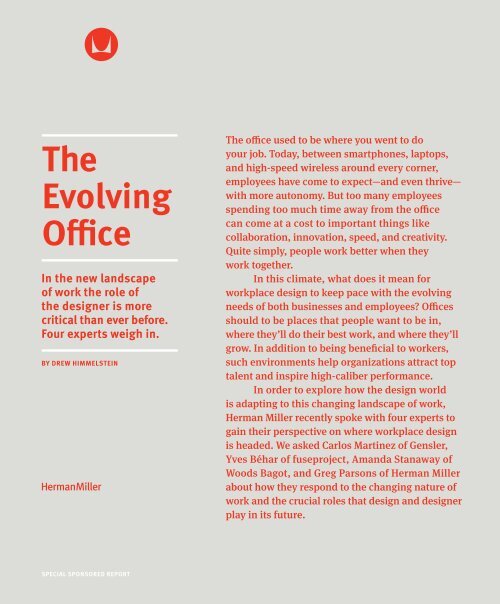Architect 2016-01
You also want an ePaper? Increase the reach of your titles
YUMPU automatically turns print PDFs into web optimized ePapers that Google loves.
The<br />
Evolving<br />
Office<br />
In the new landscape<br />
of work the role of<br />
the designer is more<br />
critical than ever before.<br />
Four experts weigh in.<br />
BY DREW HIMMELSTEIN<br />
The office used to be where you went to do<br />
your job. Today, between smartphones, laptops,<br />
and high-speed wireless around every corner,<br />
employees have come to expect—and even thrive—<br />
with more autonomy. But too many employees<br />
spending too much time away from the office<br />
can come at a cost to important things like<br />
collaboration, innovation, speed, and creativity.<br />
Quite simply, people work better when they<br />
work together.<br />
In this climate, what does it mean for<br />
workplace design to keep pace with the evolving<br />
needs of both businesses and employees? Offices<br />
should to be places that people want to be in,<br />
where they’ll do their best work, and where they’ll<br />
grow. In addition to being beneficial to workers,<br />
such environments help organizations attract top<br />
talent and inspire high-caliber performance.<br />
In order to explore how the design world<br />
is adapting to this changing landscape of work,<br />
Herman Miller recently spoke with four experts to<br />
gain their perspective on where workplace design<br />
is headed. We asked Carlos Martinez of Gensler,<br />
Yves Béhar of fuseproject, Amanda Stanaway of<br />
Woods Bagot, and Greg Parsons of Herman Miller<br />
about how they respond to the changing nature of<br />
work and the crucial roles that design and designer<br />
play in its future.<br />
SPECIAL SPONSORED REPORT

















